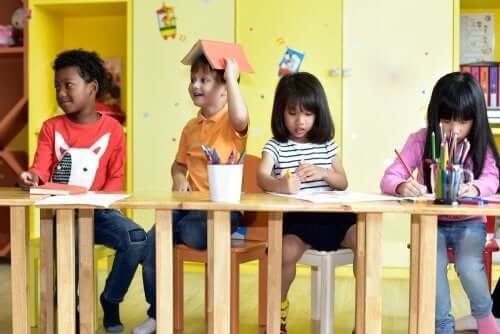The Importance of ICT in Preschool and Kindergarten

The knowledge and use of Information and Communications Technology is something that educators must promote early on. Therefore, the use of ICT in preschool and kindergarten is very important.
Preschool and Kindergarten classrooms educate children between the ages of 3 (or sometimes 2) and 6. This is the age range where boys and girls should have their first contact with Information and Communications Technology.
Information and Communications Technology (ICT)
ICT refers to technological resources, tools and programs we use to process, administer and share information. These include a variety of technological devices, such as computers, cell phones, television, game consoles, tables, etc.
Currently, Information and Communications Technology plays a fundamental role in daily life. It offers the services that “users” are accustomed to using every day. For example, email, text messaging, instant messaging, web navigation, search engines, etc. The list keeps getting longer and longer.

Information and Communication Technology puts an infinite amount of information and data at our fingertips. Therefore, developing certain technical skills related to technology use is fundamental.
The same is true for abilities related to the interpretation of information. Children need to understand that not everything that appears online is complete or totally true.
The importance of ICT in preschool and kindergarten
The knowledge and use of ICT in early childhood is important because it allows children to develop various skills. Primarily, they promote skills related to the use of computers or tablets, like tactile, auditory and visual abilities.
In second place, children develop other skills related to the didactic programs, games and applications they encounter.
In other words, the use of ICT contributes to and accompanies cognitive development of preschool and kindergarten aged children. Contact with computers, cell phones or any other technological devices from a young age facilitates and supports learning. Of course, this contact should always involve the mediation of their teachers.
The use of technology in the classroom motivates children and allows them to search for information and create strategies. It also gives them the opportunity to make small decisions as they go about their tasks. They choose, filter, select, etc.
The contributions of ICT in the preschool and kindergarten classroom
The use of ICT in the preschool and kindergarten classroom…
- Stimulates creativity.
- Encourages experimentation.
- Allows for each student to advance according to his or her personal learning pace.
- Develops budding investigation strategies.
- Awakens curiosity.
- Develops growing autonomy.
- Motivates learning.
- Helps in the development of hand-eye coordination.
ICT in preschool and kindergarten: Aspects to consider
Up until this point, we’ve addressed the advantages and the importance of ICT in early education. However, we must also talk about the proper use of ICT in the preschool and kindergarten classroom. ICT in schools can become negative in the case of the misuse or excessive use of ICT.

During preschool and kindergarten, children need an education based on play and experience with real objects. What’s more, they need contact with others and with nature, to read stories, and to develop both emotionally and socially.
It’s true that the use of technology plays its role in social, cooperative and collaborative development. Irregardless, nothing compares to socialization with other individuals, face to face, with physical contact.
At the same time, it’s also important to limit the use of ICT in preschool and kindergarten. Prolonged exposure can be harmful – affecting a child’s posture, and leading to a sedentary lifestyle and antisocial behavior.
Lastly, as mentioned above, any use of technology during preschool and kindergarten should involve permanent teacher mediation. This is true for subsequent educational stages as well.
Teachers are not only responsible for teaching how new technologies work and how to use them. Rather, they must also teach about critical and responsible use of the information children access.
Information and Communications Technology offers infinite possibilities for the immediate access to information. This means that children need to learn to interpret the large volume of information they’ll encounter. This information, on many occasions, is incomplete, biased, and should always be contextualized.
The knowledge and use of Information and Communications Technology is something that educators must promote early on. Therefore, the use of ICT in preschool and kindergarten is very important.
Preschool and Kindergarten classrooms educate children between the ages of 3 (or sometimes 2) and 6. This is the age range where boys and girls should have their first contact with Information and Communications Technology.
Information and Communications Technology (ICT)
ICT refers to technological resources, tools and programs we use to process, administer and share information. These include a variety of technological devices, such as computers, cell phones, television, game consoles, tables, etc.
Currently, Information and Communications Technology plays a fundamental role in daily life. It offers the services that “users” are accustomed to using every day. For example, email, text messaging, instant messaging, web navigation, search engines, etc. The list keeps getting longer and longer.

Information and Communication Technology puts an infinite amount of information and data at our fingertips. Therefore, developing certain technical skills related to technology use is fundamental.
The same is true for abilities related to the interpretation of information. Children need to understand that not everything that appears online is complete or totally true.
The importance of ICT in preschool and kindergarten
The knowledge and use of ICT in early childhood is important because it allows children to develop various skills. Primarily, they promote skills related to the use of computers or tablets, like tactile, auditory and visual abilities.
In second place, children develop other skills related to the didactic programs, games and applications they encounter.
In other words, the use of ICT contributes to and accompanies cognitive development of preschool and kindergarten aged children. Contact with computers, cell phones or any other technological devices from a young age facilitates and supports learning. Of course, this contact should always involve the mediation of their teachers.
The use of technology in the classroom motivates children and allows them to search for information and create strategies. It also gives them the opportunity to make small decisions as they go about their tasks. They choose, filter, select, etc.
The contributions of ICT in the preschool and kindergarten classroom
The use of ICT in the preschool and kindergarten classroom…
- Stimulates creativity.
- Encourages experimentation.
- Allows for each student to advance according to his or her personal learning pace.
- Develops budding investigation strategies.
- Awakens curiosity.
- Develops growing autonomy.
- Motivates learning.
- Helps in the development of hand-eye coordination.
ICT in preschool and kindergarten: Aspects to consider
Up until this point, we’ve addressed the advantages and the importance of ICT in early education. However, we must also talk about the proper use of ICT in the preschool and kindergarten classroom. ICT in schools can become negative in the case of the misuse or excessive use of ICT.

During preschool and kindergarten, children need an education based on play and experience with real objects. What’s more, they need contact with others and with nature, to read stories, and to develop both emotionally and socially.
It’s true that the use of technology plays its role in social, cooperative and collaborative development. Irregardless, nothing compares to socialization with other individuals, face to face, with physical contact.
At the same time, it’s also important to limit the use of ICT in preschool and kindergarten. Prolonged exposure can be harmful – affecting a child’s posture, and leading to a sedentary lifestyle and antisocial behavior.
Lastly, as mentioned above, any use of technology during preschool and kindergarten should involve permanent teacher mediation. This is true for subsequent educational stages as well.
Teachers are not only responsible for teaching how new technologies work and how to use them. Rather, they must also teach about critical and responsible use of the information children access.
Information and Communications Technology offers infinite possibilities for the immediate access to information. This means that children need to learn to interpret the large volume of information they’ll encounter. This information, on many occasions, is incomplete, biased, and should always be contextualized.
All cited sources were thoroughly reviewed by our team to ensure their quality, reliability, currency, and validity. The bibliography of this article was considered reliable and of academic or scientific accuracy.
- Belloch Ortiz. C. (n.d.). LAS TECNOLOGÍAS DE LA INFORMACIÓN Y LA COMUNICACIÓN (T.I.C). Unidad de Tecnología Educativa. Universidad de Valencia. Recuperado de https://www.uv.es/~bellochc/pdf/pwtic1.pdf
- Romero Tena, R. (2009). Nuevas tecnologías en Educación Infantil. El rincón del ordenador. Editorial Eduforma. Sevilla.
This text is provided for informational purposes only and does not replace consultation with a professional. If in doubt, consult your specialist.








